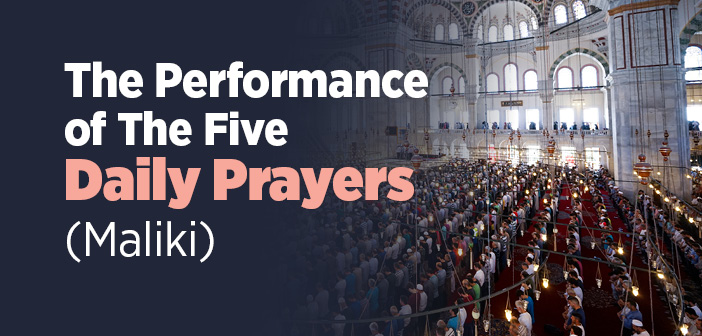What is the performance of the five daily prayers?
Below we are going to suffice with explaining the performance of the Fajr prayer out of the five daily prayers and we are going to explain the differences between the other prayers and the Fajr prayer.
When one starts the salat, they make the takbir by saying “Allahu akbar’’. The takbir will not be carried out if other words are recited. The person who is praying raises their hands up to their shoulders or a bit below the shoulders, they then start reciting the qiraat. During the Fajr prayer, Surat Al-Fatiha is read out aloud, the basmala is not recited for Surat Al-Fatiha or for the surah that follows.
When “waladdallin” is recited at the end of Fatiha the person who is praying on their own or the one that is following the imam will say “amin” in a quiet manner. The imam will not say this for the prayers in where the qiraat is read out aloud, he will say it for the quiet prayers. After this a surah is read. For the Fajr prayer, this surah is read out aloud. When the recitation is finished, the takbir is made while bowing down for the ruqu.
When in the position of ruqu the head is not lifted, there is no slouching, the biceps must be kept far away from the two sides of the body. While at ruqu, the words “subhana rabbiya’l-adhim” are recited. There is no limit as to how many times this may be recited. After this, the body is straightened up from the ruqu whilst the words “semiallahu liman hamidah” are recited. After straightening up from the ruqu position, the person who is praying on their own will say the words “Allahumma rabbana wa laka’l-hamd’’. The imam does not say this. The person who follows the imam does not say the words “semiallahu liman hamidah”, they will say the words “Allahumma rabbana wa laka’l-hamd’’.
Afterwards the person will stand in an upright position without moving and with their hands hanging by their sides, they will then go down to make the sujud by saying Allahu akbar. The forhead and nose will be pressed up against the ground, the hands are placed on the ground facing towards the qiblah, the fingers are spread out and held at the position of where the ears are, or even more below. At the time of the sujud, the elbows are not placed on the ground and the arms are not to be joined to the body. During the sujud the feet are kept upright, the inner part of the thumbs of the toes are placed on the ground. If it is desired duas such as; “Rabbi dhalemtu nefsi wa amiltu suan faghfir li” may be read. There is no fixed time for staying at the sujud. Along with this, the minimum amount of time for staying at the sujud is for the joints to stay without movement for just a moment. After this, the person sits up from the sujud by saying “Allahu akbar’’. While sitting between the two sujuds the left foot is placed on the floor, the right foot is placed on the floor and straightened up so that the toe thumb touches the ground. The hands are lifted from the ground and placed on the knees. After this, the second sujud is made in the exact manner as the first one. After this the person gets up by pushing themselves off the floor with their hands. While getting up the takbir is recited.
For the second rakat, a portion of the Qur’an is recited the way in which it was read in the first rakat, or even less than what was read in the first rakat. The actions carried out in the first rakat are carried out in the same way in the second rakat. During the Fajr salat, after the ruqu of the second rakat or after the qiraat has been recited, the kunut dua is recited before the ruqu. The kunut dua is like this:
Allahumma inna nastai’nuka wa nastaghfiruka ve nu’minu bika wa natawakkalu alayka wa nahlau wa natruka man yekfuruk.
Allahumme iyyaka na’budu wa laka nusalli wa nasjudu wa ilayka nes’a wa nahfid. Nerju rahmataka wa nehafu adhabaka’l-jidd. Inna adhabaka bi’l-kafirane mulhik.
Afterwards, as it was explained before in the sujud and sitting, the sujud and sitting is carried out. After the two sujuds are made, the person who is praying straightens their right foot and presses the toes that are touching the foot to the ground, they lean their left foot to the ground, they lean their hip against the ground, they do not sit on top of their left foot. Afterwards they recite the tashaddud. The tashaddud is as follows:
At-Tahiyyatu lillahi’z-zakiyatu lillahi’t-tayyibatu’-s-salawatu lillah. Assalamu alayka eyyuha’n-nabiyyu we rahaetullahi wa barakatuh. Assalamu alayna wa ala ibadillahi’s-salihin. Ashadu alla ilale illallahu wahdahu la sherike leh. Wa ashadu anna Muhammadan abduhu wa rasuluh.
The salat will be considered sufficient if the person recites the salam after this. If they wish, they may add these to their recitations:
Wa ashadu annalledhi jae biha Muhammadun hakkun wa anna’l-jannata hakkun wa anna’n-nare hakkun wa anna’s-saate atiyetun la rayba fîha wa annallahe yeb’asu man fi’l-gubur.
Allahumma salli ala muhammadin wa ala ali Muhammadin warham Muhammadan wa ala Muhammadin wa barik ala Muhammadin wa ala ali muhammadin kema sallayta wa rahimte ve barakta ala İbrahima wa ala ali İbrahime fi’l-alemine inneka hamidun mejid.
Allahumma salli ala melaikatika wa’l-mugarrabina wa ala anbiyaike wa’l-murseline wa ala ehli taatike ejmain.
Allahummaghfirli wa liwalidayya wa lieimmetina wa liman thabaka bi’l-imani maghfiratan azma.
Allahamma inni es’eluka bin kulli hayrin seeleke minhu Muhammadun nebiyyuke wa audhu bike min kulli sharin isteazaka minhu Muhammadun nebiyyuka.
Allahummghir lena ma gaddemna wa ma ahharna wa ma esrarna wa ma a’lenna wa ma anta a’lemu bihi minna.
Rabbana atina fi’d-dunya hasanatan wa fi’l-akhirati hasanatan ve gina azabennar.
Audhu bike min fitneti’l-mahya wa’l-memat wa min fitneti’l-kabri wa min fitneti’l-mesihi’d-dajjal wa min azabi’n-nari ve sui’l-masir.
Assalamu alayka ayyuhannabiyyu wa rahmetullahi wa berakatuh. Assalamu aleyna wa ala ibadillahi’s-salihin.
After this, the person recites the salam to the right side by saying the words “assalamu aleykum” once. With this they are referring to the front side of their face, they turn their head slightly towards the right. The imam and the person who is praying on their own does it in this way. The person who is following the imam looks slightly to the right only once and says the salam. After this he replies to the salam of the imam. He replies to the salam of the person sitting to his right. If no one from the left side has given him salam, he does not give any reply to that side.
The person places their hands on their knees at the time of the tashaddud. They clench their right hand, they move their thumb forward and erect the front side towards their face. They place their left hand on their knee, they do not move it or indicate anything with it.
The qunut du’a is not recited for the fard prayers other than the Fajr prayer. The person prays the third and fourth rakat in the same way that they prayed the first two rakats.
Source: Fiqh1 (According To The Maliki School Of Islamic Law), Erkam Publications





